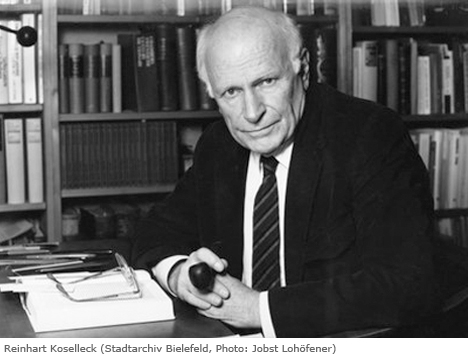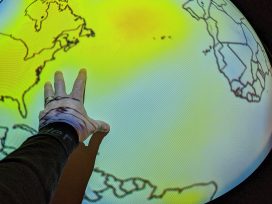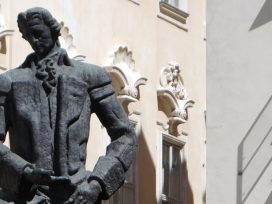Critique expresses the possibility that everything could have been different. By doing so, critique puts things and the order of things in a state of crisis – institutions, meanings, relationships, mental and cultural dispositions. Realities emerge as possibilities, possibilities that have materialised. In other words, critique is an expression of the equal importance of the possible and the real. In The Man Without Qualities, Robert Musil writes that “the sense of possibility” exists alongside “the sense of reality” and that “possible realities”, not “real possibilities”, are what is really interesting.
It has been said that critique is a genuinely modern disposition, just as crisis is a genuinely modern societal and mental state. The urban sociologist Robert Ezra Park wrote that the city – the ultimate manifestation of modernity, both with regards to social order and mentality – was in, or even constituted, “a permanent state of crisis”.
Critique and crisis are central categories in any understanding of the modern culture. The concepts have a common etymological origin. They describe a state where nothing is yet determined but is soon to be; a state all about decisions, distinctions and discernment. The Greek word krínein meant both “subjective critique” and “objective crisis”. The concepts achieve their real significance and are filled with opportunities and potential during the modern age, from the Renaissance and Reformation up to the present. They become significant because they reflect, explain and portray relationships that during the modern age and modernity became fundamental and essential: social and political relations, material and immaterial institutions, values, norms, meaning. The development also reflects the self-awareness of modernity – which is always at least latently critical and results in a situation where mankind and society and the relationship between them is characterised by ambivalence and ambiguity, or simply crisis.
The critical (meaning the modern) disposition observes and embodies everything it takes on – and it takes on everything; practical, theoretical, ideological, technical – as crisis-like, as critical. The crisis-like or critical character of everything admits and evokes critical judgement. Modernity takes hold of and absorbs its surroundings and has embraced the Greeks’ krínein as its trademark.
Koselleck

The genesis of modernity in terms of critique and crisis is the subject in Reinhart Koselleck’s half-century old investigation Critique and Crisis. The study originates in the blood stained and confused religious wars and the solution that was the absolutist state, and ends in the French Revolution, in the utopias and terror. The early modern age starts and ends in existential, social and political crisis, and this crisis opens up the possibility for critique, develops it and eventually contributes to the success of critique. In other words: the historical origin of critique can be found in the crisis, and both the historical answer to this crisis and crisis itself are the outcomes of critique. Critique and crisis are essentially historical categories.
Koselleck portrays the genesis of modernity, its incubation period, during the centuries prior to 1789. However, he also interprets and depicts important elements of the society and the mentality that remain valid. Critique, as a concept, experience, disposition and practice, is a historical force that originated in, has been shaped by and even contributed to the historical development that still determines our lives, regardless whether we consider ourselves to be post- or late- modern.
Koselleck became an influential historian during the second half of the twentieth century. In many ways, his work is characterised by plurality. Jacob Taubes, a sociologist of religion, labelled him “partisan”. He did not follow any certain school before him, and did not leave one behind. The theory of history and iconography are reoccurring areas of interest. Koselleck’s most prominent ideas were those of the history of concepts and mentality. In the encyclopaedia Geschichtliche Grundbegriffe, which Koselleck published with Werner Conze and Otto Brunner, many of the concepts that characterise modernity – revolution, state, capitalism, society, progress, crisis, critique – are thoroughly examined in articles of great length. The historian of ideas sees concepts as indicators as well as factors, as testimonies of typical and significant facts and ideas. The fundamental historical concepts of modernity together constitute a kind of mental blueprint.
Plurality is also characteristic of Koselleck’s understanding of human nature. Historical events escape the pretentions of the philosopher of history. They create irreducible pluralities, encompass different levels of meaning and time and imply a perspectival brokenness when they are interpreted and reproduced. At the same time, the historian is free to depict the events and processes that are to be analysed. Historiography thus involves objective descriptions of minor and major things, but also theoretical arrangements, even poetic portrayals. Contexts, structures, meanings, all these silent, invisible and indemonstrable conditions have to be extrapolated and given shape. Only then can events and actions be understood. Koselleck conducts historical hermeneutics – and historical heuristics.
Critique and Crisis is Koselleck’s first book, and one of his few monographs. The influences of his teachers are obvious – Martin Heidegger, Hans-Georg Gadamer, Karl Löwith, Carl Schmitt. The exploration is conducted by the historian as sovereign interpreter of a complex historical process. In a most suggestive way, the modern age is narrowed down to two almost archetypical concepts, two experiences, two dispositions in a dialectical game, and is granted an eternal, contradictory and ambiguous meaning and direction.
Critique and crisis
How do critique and crisis develop into fundamental elements of the modern and modernist periods? The modern age came about as a consequence of the disruption of Christianity and the confessional wars. Hobbes’ theory of the state and individualistic anthropology is essentially an expression of a historically unbearable situation. (Correspondingly, Descartes’ search for a rigorous method becomes apprehensible.) Appetitus and fuga, desire and fear, emerged as fatal human characteristics. War is the state of nature, peace something to be desired. Hobbes introduced the state as the peacemaker, neutral and unwilling to compromise with religious fanatics. Leviathan materialised reason, which required the state to have its genes in fear and death. The absolute, absolutistic state – that in Hobbes is “not only a vast mechanism, but also an artificial man whose soul is sovereignty” – eliminated consciousness as politicum. However, at the same time it acknowledged, or created, a private space for religion, deliberation and aspirations. Here, within the subordinate, a sphere of no interest to the sovereign, the religious, reflective human being could practice religion and reflect at her own discretion. This was also the space for critique. It just had not been thought of yet, it had not been formulated, and it lacked self-awareness.
Hobbes was contemporary. His draft became the blueprint for the modern state in places where there was a latent critique of the state that was currently protecting people from the war against all. The power of the sovereign put an end to the crisis through the practice of politics and made politics in to an art. But absolutism also sowed the seed for the next important crisis. Critique developed between these two crises.
The absolutistic state as a guardian of peace and order fulfilled a functional role. However, as peace was gradually normalised, the sovereign lost its legitimacy. The indispensible nature of the state became disposable. It even went further, because “protection by the state was replaced by protection from the state”.
The personal sphere increased and changed character. Innocence disappeared. It could be private and involve the shaping of the individual or it could be collective. It was moral and moralising. Morals – the critical moral, the moral critique – came to consider itself superior to the explicitly morally neutral state. Morality and critique became the art that taught people that princes and states are disposable – it became a challenging art and competing politicum.
The secret was the location of morals. It was here that new ideas regarding freedoms and rights developed: “in his private world man was free; there alone was he human.” And: “Freedom in secret became the secret of freedom.” The hidden was the essence of the existence for the Illuminati and Freemasons. The Freemasons expressed the social interests of the new bourgeois, but more importantly they expressed the ideas of the enlightenment. The Masonic Lodge expressed a moral verdict of the sovereign prince both through its critique and its mere existence; in contrast, the prince saw a reduction in his area of control and appeared despotic.
Morals – freedom and critique – had other locations as well. Conceptions of society (La Société, die Gesellschaft) appeared – a sphere both external and in opposition to the state that was populated by the bourgeois, oppositional nobility, judges, philosophers and writers. The theatre adopted the role of the courts. The arts could or should be critical and moral and oppose the state. Art casts its harsh, incomplete verdict on the political, but withdraws at the same time. Schiller, who may have been a Freemason, wrote an essay about “The Stage Considered as a Moral Institution”.
The eighteenth century was the century of the Enlightenment. Critique became a central category and disposition – explicit, self-conscious and inalienable, it became the expression for how reason progressed towards truth, knowledge and freedom. Critique emerged and acted as both prosecutor and judge. Critique was also compatible with different positions, or rather presupposed different positions. Absolutism had ended the religious civil wars; but now war emerged again, and this time it was an intellectual war that was pursued, where politics was the common enemy but where the faces of morality and freedom was otherwise versatile. A fundamental ambivalence tainted critique: “ostensibly non-political and above politics, it was in fact political”. Science and art both became, directly or indirectly, weapons in the critique of the political and when critique was met with critique. Diderot wrote that critique was sovereign everything: Tout est soumis à sa loi.
The emergence of a critique that at first was apolitical, but later became overtly political is nothing less than the emergence of an epoch, namely the world of the bourgeois. This world owned the public sphere (Jürgen Habermas writes parallel to Koselleck about the emergence and nature of “the bourgeois public sphere”). Additionally, the public owned its own type human being (Richard Sennett talks about the nature and later fall of “the public man”).
The world of the bourgeoisie was also the epoch of secularisation. Religion was replaced by the critical moral, the moral critique. Theology was replaced by the philosophy of history. The idea of progress took a central role in the philosophy of history and replaced the role and function of the Christian eschatology. History was equated to progress – of reason, morality, freedom and critique. Inversely, reason and morality, and critique and freedom immediately guaranteed progress. The philosophy of history gathered the differentiated, pluralistic conceptions of reality in a “collective singular”. If reason and moral were the components that guaranteed progress, the philosophy of history was the ultimately reinsuring instance. Historical change was necessary, bound by laws, called for and made even the existing realities open to change. It could, would, must be different.
Philosophy of history and crisis emerge as reciprocal categories. This reciprocity originates in the critical process that the bourgeois intellect has pursued against the state. The critique has been formulated within philosophical history; the critique foreshadows the crisis, which is a historical-philosophical imperative. An altogether obvious history, enlightened, and reasonably observed.
The French revolution was secluded in the private room that absolutism had created and which would develop as moral, critique, reason, freedom, secret, public. Crisis would lead to crisis. To revolution: a crisis that had been driven to two absolutes, absolutely opposite alternatives, namely freedom or slavery, reason or etatism.
The claim of the revolution was absolute and universal and was opposed to the prince as a special interest. The morals and reason of the enlightenment was valid “from China to America, from Paris to Peking”, did not discriminate between external or internal, between states or between state and individual, humans and citizens. Absolutist, now despotic politics had rested on these differences and was currently widely challenged. Voltaire, a freemason, wrote that “il n’y a qu’une morale […] comme il n’y a qu’une géométrie”.
The political reality of the new crisis, meaning the revolution’s, was civil war. Dictatorship ascended from the confusion. Dictatorship perverted the ideals of the enlightenment by politicising morals, substantiating the general will, dissolving the difference between state and society, state and human – through an unconditional submission. The space for consciousness which Hobbes’ blueprint left untouched became the focal point of the dictatorship; Rousseau wrote that “l’autorité la plus absolue est celle que pénètre jusqu’à l’interieur de l’homme”. Fear of death was also fear of the state. This state expressed the concentration of the crisis, not its neutralisation.
The crisis of 1789 saw an end to the long critical process that began with the privatised consciousness, and accelerated during the eighteenth century, the century of “critique and crisis”, and particularly the latter half, die Sattelszeit, when everything seemed irrevocable and Europe ventured into modern times where the crisis “lies hidden in the criticism”. Conversely, critique had been concealed in the crisis, the crisis that was manifested in the European confessional wars. The modern era starts in crisis, continues in a state-centric order as well as increasing critique, and ends it’s early, not yet modern phase in a new crisis. Just as in a crisis of critique itself, critique became a dictatorship: the latter half of the eighteenth century is not only état de crise, but also la crise de l’état, firstly the crisis of the absolute state, and later the crisis of the dictatorship (or rather: the dictatorship as a crisis).
Commentary
Koselleck’s portrayal of the genesis of modernity is dense. Critique and crisis are constituent, controlling, significant and typical elements. The genesis is “pathogenic”, not because it would be about a story of deterioration, but rather because it is marred with suffering – from religious and revolutionary wars, from the loss of experience and experience of losses which becomes reality once modernity is in motion. Koselleck writes that modernity is in “a state of permanent crisis”, crisis is the “signature of the modern era”, “the elastic paradigm of the modern era”. Koselleck also writes that “because of its diagnostic and predicative meaning, the term “crisis” became the indicator of a new awareness”, which in turn corresponds to a society essentially characterised by Herrschaftslosigkeit, the absence of legitimate political and social order.
It was the fundamental social order that Nietzsche indisputably depicted in the portrayal of “The Death of God”; he also described the modern existence as “hanging in dreams, as it were, upon the back of a tiger”. Nietzsche’s images remain archetypical.
The modern awareness of crisis, or the modern consciousness as crisis consciousness, is the consciousness that, latently or overtly, is critical to the world. The critique sweeps and makes everything disposable to critique, to the possibility of understanding and doing things differently. If everything can be understood and done differently, then the crisis is real. Then the critical mindset is once again necessary and possible. The dialectic between critique and crisis determines modernity, not only in terms of its pathology but also its freedom. Freedom expresses and presupposes that everything could have been different, that everything could be understood in a different way. The freedom of modernity is always a possibility. However, it also manifests coercion. The modern human being must transform freedom to meaning – a meaning that always can be different. The outcome- modernity – is a society that is characterised by less order and reality, truth and meaning, and more regimes and realities, truths and meanings.
Critique and crisis should be understood from a historical or historical-sociological perspective. They are created in specific historical and social contexts as experiences and dispositions. Similarly, they cannot be conceived of and experienced separately, beyond the historical dialectic that they express. This is a focal point in Koselleck’s argument. Historical contexts are also subject to the theoretical concepts and fantasy of the historian. They cannot necessarily be proven, but their nature can be made plausible.
The transformation of time, human beings and society into concepts with historical meaning is characteristic of the period that Koselleck examines, i.e. the early modern era and the beginning of modernity. Time is conceived as a force, as historical time, as history, it accelerates and encompasses differences, expresses progress and development and occasionally some calmness. Different cultures and ways of life can be found in the same place, at the same point in time. The present time is a permanent shift, “horizons of expectations” are emancipated from the “space of experience” in which they were previously enclosed. Knowledge loses its absolute, eternal, timeless properties in favour for the historical, subjective perspective.
In other words, life changed character; nothing seemed necessary and everything seemed possible. Everything could be in another way- a (critical) hunch became a (critical) certainty, which in turn took the shape of its own dynamics according to which everything constantly changed, everything was subject to history and thus was in a state of permanent crisis. Paul Valéry speaks of the “epoch of the provisional”. Modernity: the permanent and provisional only seemingly incompatible.
Prototype, example
Critique means critique of one’s contemporary – that is the conclusion Koselleck reaches from the historical material he employs – philosophical and historical observations by Hobbes, Vattel, Locke, Lessing, Boyle, Voltaire, Diderot, Turgot, Rousseau, Raynol, each paradigmatic for their time, representative of the mentality.
Critique as critique of the present was called for and sometimes programmatic. It would become a reoccurring and vital disposition in the modern culture. Kant was prototypical. Foucault was a latter example.
Kant discussed critique and its different meanings. There was one critique that sought for the ahistorical and there was another that was concerned with the historical. The former critique was concerned with the boundaries of rationality and judgement, with what we can and cannot know. It may be plausible to say that Kant’s ambitions here merged with Hobbes and Descartes; they all sought certainty, finitude, and solidity in a world that was undergoing fundamental changes. Kant does not refer to critique as a historical notion, or as critique of society, but he refers to this as enlightenment. In the famous article that responds to the question what enlightenment is, Kant argues that enlightenment is human being’s “emergence from his self-imposed immaturity”, it is her genesis as an autonomous and sovereign entity. Enlightenment is, in other words, the emancipation of mankind and reason from religion and other beliefs. Enlightenment is also courage – the courage to know, the courage to get to know oneself, the courage to admit the critical boundaries of reason. Enlightenment is also a critique of the contemporary and the impact it has on the way we live our everyday lives, along with the insight that everything can be subject to philosophical and other kinds of reflection – as long as it does not fall in to the metaphysical category of pure concepts, of which we can have no empirical knowledge but can envision.
Kant sees the human being from both a philosophical-anthropological and historical-anthropological perspective. She is constant and she is changing. In Anthropology from a pragmatic point of view, also called the “fourth critique” that attempts to answer what the human being is, Kant presents a human being who changes according to the historical context. Kant emphasises that the human being is neither subject to natural instincts nor divine, but rather a unique kind of life, namely the human kind, doomed to raise itself and develop on its own. Kant’s anthropology is an understanding and criticism of the contemporary, a modern, critical anthropology, which relates to his own doctrine as well as Koselleck’s historical denotation of critique as “critique of the present”: If I am to understand the human being, I first have to understand her context and condition. This historical situation is not just factual and real, but a possible other, a situation that will become something else and will bring about another form of human life. Modernity is one long testimony of the relevance and validity of Kant’s critique of the present.
Foucault followed Kant. Sometimes Kant refers to the role and emancipated ability of the Enlightenment as well as the philosopher, but also of the modern human being, to reflect on their living conditions as critique and sometimes enlightenment. Foucault writes that that Enlightenment means a “permanent critique of our historical era”. The task of philosophy, Enlightenment philosophy, an enlightened philosophy, is to determine the “ontology of the present”. The real, or the ontology of the present, is the contemporary that is in a constant state of flux, a persistent transformation of the result of historical events. It constitutes the conditions for the genesis of mankind in terms of power, knowledge and subjectivity. The actuality, or every new actuality, is a “field of opportunities” that also makes it “reversible”. Critique and enlightenment essentially belong to the same category. So does modernity. For Foucault modernity is primarily “an attitude” – a permanently critical attitude of the provisional condition that characterise living conditions. According to Foucault, Kant was the first modern philosopher, an example of the “attitude of modernity”.
There is also a more narrow and political understanding of critique in Foucault. The similarities to Koselleck are obvious. The transition to modernity, the “formative stage for modern humanity”, meant a move from the power of the sovereign to “disciplinary power” and “bio-power” respectively. People become individuals and the mob – or those who happen to live within a certain territory become a population. New rational practices and mentalities emerge and are differentiated. It is an answer to the historical predicament and historical options, which occasionally collide; a society whose ontological disposition is diffuse is an essentially open society, it expresses an insufficient existing order – society in crisis, society as crisis – as well as a clearly constructive potential and consequently new possible orders. Foucault speaks of governmentality. The state asks the question: how can and how should one govern? Rationally? Optimally? The human being, the individual and the collective, poses the question, the critical question, the core question in all political philosophy: how and under what conditions can I let myself be governed? What is reasonable considering the functions of society, what is inacceptable with regards to my own rights? Critique becomes for Foucault “the art of not being governed quite so much”, “the art of voluntary insubordination, that of reflected intractability.” Critique is also a constantly relevant question because the disciplines and bio-powers continuously differentiate: critique is the “partner and adversary” of governmentality. It is a relationship, a fight which can be found in the human soul, this greatness that can also be understood as the most personal, as the hub of power or the social, as the “prison of the body”. “Conduct” and “conduct of conducts” are complementary entities. Critique, a critical way of life, is a thoroughly complex, problematic, libertarian question, an oscillation between subjection and refusal, between autonomy and sovereignty.
Critical outline
Koselleck tells the story of how the modern era unfolds and modernity is created. It is a historical and historicising perspective on what critique is, its meaning and its context. Critique is intimately intertwined with crisis – as a reality, ideal, option, outcome, motivation and as a vital modern disposition. The critical disposition is also related to the enlightenment, reason, autonomy and sovereignty. They cannot be understood without each other. They can be equated to each other.
In the end, Koselleck shows, just like Kant and Foucault, that critique is a question about distance or exteriority. The absolutist state relegated consciousness and faith to the private sphere. Critique, morality, reason, enlightenment, civilization emerged from this private sphere. A new critical situation developed as a result of the increasing critique, a common experience that expressed that it did not have to be that way, and it shouldn’t be; it was a shared experience of both uncertainty and anticipation – a revolutionary anticipation. Critique and morality was also an issue of individual autonomy and sovereignty. Or about individualism in general. Individualism is essentially an expression of that life can be lived in different ways. Individualism does therefore always mean critique.
Individualisation is a modern anthropological tendency. Another is totalitarianism. (It is one of the most prominent characteristics of modernity to be one and the other simultaneously.) The analyses of the totalitarian tendencies of modernity range from Tocqueville, Nietzsche and Simmel via critical theory and Arendt to Sennett, Baecker and Bauman. Social immanence, mass, conformity, standardisation are reoccurring keywords. Tocqueville observed in his study of the democratic culture in America that people were individualised but at the same time was subjected to conformity. “The masses” practiced their own “tyranny”: each individual has the right to their own opinions and expressions, but as soon as the norm is challenged she will slowly be rejected. Almost two centuries later, Richard Sennett writes about how “flexible” people are and how “flexible” organisations are required in a society that is reduced to a “flexible capitalism” – flexibility is both the ideal and the most tangible reality, it does most certainly express that things can be done and understood differently, that people can live in different ways, but essentially only as long as the continuous conformity is not challenged. Continuity continues and is augmented through communication, which has become the trademark of current times. (Norbert Bolz writes that communication is the contemporary religion and the networks our gods.) People reside in different realities – virtual, material, conventionally immaterial (norms, values) – and are expected to multitask their social lives. It is all upheld by constant, and accelerating, communication, one is compatible with the other. Zygmunt Bauman writes that everything is transformed to a fluid state, which is eternal, shapeless and imminent simultaneously.
The totalitarian tendencies of modernity undermine what was unique about the Enlightenment – the combination of morality and reason and individuality, autonomy and sovereignty. Furthermore, it undermines the critical fundament that the Enlightenment was a manifestation of, and that enabled us to think about reality in a different way, or that our “sense of possibility” is as important as our “sense of reality”, as Musil claims.
Or even more important. Because Musil also writes that “everything he encounters behaves as though it were final and complete. He suspects that the given order of things is not as solid as it pretends to be; no thing, no self, no form, no principle is safe, everything is undergoing an invisible but ceaseless transformation, the unsettled holds more of the future than the settled, and the present is nothing but a hypothesis that has not yet been surmounted”.







